

Natureplast bioplastics coproducts range. Brevetto sardo per uso lana in edilizia - Sardegna. Un brevetto tutto sardo per usare la lana in bioedilizia.
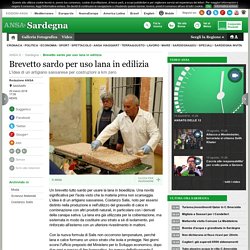
Una novità significativa per l'isola visto che la materia prima non scarseggia. L'idea è di un artigiano sassarese, Costanzo Salis, noto per essersi distinto nella produzione e nell'utilizzo del grassello di calce in combinazione con altri prodotti naturali, in particolare con i derivati della canapa sativa. MATER-BI - bioplastiche biodegradabili e compostabili - Novamont.
Il MATER-BI è la nostra innovativa famiglia di bioplastiche biodegradabili e compostabili, sviluppate grazie a venticinque anni di ricerca e innovazione per offrire soluzioni a specifici problemi ambientali conciliando qualità e performance dei prodotti con l’efficienza dell’uso delle risorse.
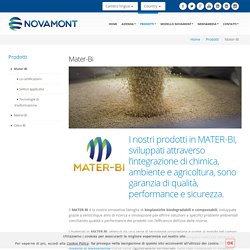
I materiali in MATER-BI, ottenuti da una serie di tecnologie proprietarie e prime al mondo nel campo degli amidi, delle cellulose, degli oli vegetali e delle loro combinazioni, vengono realizzati attraverso una filiera integrata che coinvolge ben tre siti produttivi italiani. Questi siti, in linea con il nostro modello di bioeconomia intesa come rigenerazione territoriale, sono stati rivitalizzati in innovativi impianti industriali. Bioplastica — Canapa Industriale. Zero Waste Italy: il premio alla bioplastica di canapa di Kanèsis La bioplastica di canapa creata dalla start-up siciliana Kanèsis si è aggiudicata il premio “Zero Waste Italy, Le Buone Pratiche di Impresa Verso Rifiuti Zero”.
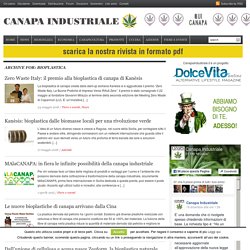
Matech compositi innovativi. Compositi Innovativi. Fibre naturali2012. 104 RdS. Company develops new fiber-reinforced wood, concrete ink for 3D printing. Even though 3D printing is an emerging market and technology, aside from Defense Distributed’s gun, it seems like it has hit a plateau.

You can make little or somewhat-bigger-than-little figurines, teacups and mugs that often have leaks, or fragile parts — such as gears — that you can include in a working item, but might quickly wear down. One of the things holding 3D printing back is the material used to print objects. A San Francisco-based company, Emerging Objects, has created new printing materials that aren’t just plastic, but composed of wood, concrete, and even salt. For the uninitiated, normal 3D printing is additive. A nozzle (or nozzles) squirts out a material — usually some kind of plastic in a gooey state — and meticulously dumps layers of plastic onto a base, following the schematics of a preset model.
Emerging Objects has developed a wealth of new materials, such as paper (made from recycled newsprint) as well as a printable salt material. Market study on “Bio-based Polymers in the World” Www.inter-plast.info/Portals/0/Files/biopolimeri_potenzialità_mercato_ricerca_IT.pdf. Www.plasticconsult.it/www.plasticconsult.it/documents/Il_mercato_dei_polimeri_compostabili_2013_Ricerca_Plastic_Consult.pdf. Www.plasticconsult.it/www.plasticconsult.it/documents/La_Struttura_dell'estrusione_film_in_bolla_-_focus_shopper.pdf. Press release - Market study on "Bio-based Polymers in the World - Capacities, Production and Applications: Status Quo and Trends towards 2020"
24 July 2013 Europe’s current position in producing bio-based polymers is limited to a few polymers.

However, new developments and investments are foreseen: the first European industrial-scale PLA plant by 2014, the introduction of future PET production facilities by 2015, recent developments in the commercialization of bio-based PBT and further advancements in the field of high-value fine chemicals for PA, PUR and thermosets production. Although Europe shows a strong demand for bio-based polymers, production tends to take place elsewhere, namely in Asia and America. Certificazione bioplastiche. Resine: documenti, foto e citazioni nell’Enciclopedia Treccani. ENEA - bioplastiche in Italia. La crisi attuale ci spinge ad adottare un modello di sviluppo più inclusivo ed equilibrato, che trasformi il sistema produttivo e le abitudini consumo in chiave sostenibile.

La bioeconomia e, in particolare, i prodotti ad alto valore aggiunto come i biochemicals e le bioplastiche, rappresentano delle concrete risposte a tale necessità. European Bioplastics. » Bioplastics and global sustainability. Application of bioplastics is in its infancy stage but holds significant promise in developing sustainable plastics for the future.
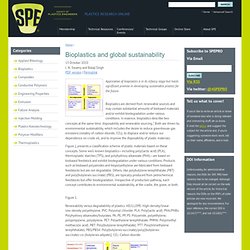
Bioplastics are derived from renewable sources and may contain substantial amounts of biobased materials and/or exhibit biodegradation under various conditions. In essence, bioplastics describe two concepts at the same time: disposability and renewable sourcing.1 Both are driven by environmental sustainability, which includes the desire to reduce greenhouse-gas emissions (notably of carbon dioxide, CO2), to displace and/or reduce our dependence on crude oil, and to improve the disposability of plastic materials. Figure 1 presents a classification scheme of plastic materials based on these concepts. Some well-known bioplastics—including poly(lactic acid) (PLA), thermoplastic starches (TPS), and polyhydroxy alkanoate (PHA)—are based on biobased feedstock and exhibit biodegradation under various conditions. Www.hgca.com/publications/documents/Bioplastics_web28409.pdf.
Market_Study_Bioplastics.pdf. Polymers Luisa Pereira and Manuela Donoso collaborated on this musical instrument made of elastics and light.

On the first version they used regular elastics coated with conductive ink and on the final version opted for stretch ... In this video Becky Stern from Adafruit shows how to make a simple circuit on a transparent sheet of plastic coated with indium tin ... Heart On Your Sleeve from Scott Garner on Vimeo. Endlighten is an acrylic sheet infused with colorless light diffusing particles.
While regular acrylic only diffuses light around the edges, ... light diffusing acrylic Materials 101, Polymers Shape memory polymer strips (image by Inventables) Heat Reactive Materials Heat reactive materials change state, shape and/or color when exposed to temperatures above ambient. Heat reactive polymers Empa's EAP propelled airship with Dielectric Elastomer (DE) actuators as ...
EAP propelled airship. Polymers. Polymers 1.
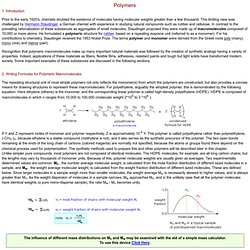
Introduction Prior to the early 1920's, chemists doubted the existence of molecules having molecular weights greater than a few thousand. This limiting view was challenged by Hermann Staudinger, a German chemist with experience in studying natural compounds such as rubber and cellulose. In contrast to the prevailing rationalization of these substances as aggregates of small molecules, Staudinger proposed they were made up of macromolecules composed of 10,000 or more atoms. Recognition that polymeric macromolecules make up many important natural materials was followed by the creation of synthetic analogs having a variety of properties. 2.
The repeating structural unit of most simple polymers not only reflects the monomer(s) from which the polymers are constructed, but also provides a concise means for drawing structures to represent these macromolecules. New applications: PLA-wood fibre composites. (Published on December 2007 – JEC Magazine #37) Following the presentation “New applications in the woodplastics composites sector: the French example” by the author at the Biocomposites Forum of the JEC Composites Show 2007, new developments, applications and products are now available.
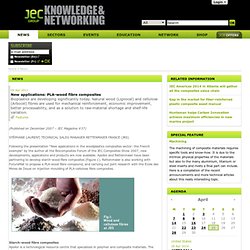
Apollor and Rettenmaier have been partnering to develop starch-wood fibre composites (Figure 1). Rettenmaier is also working with FuturaMat to propose a PLA-wood fibre compound, and carrying out joint research with the Ecole des Mines de Douai on injection moulding of PLA-cellulose fibre composites. Tesina bioplastiche. Lezione 6 biomateriali polimerici. Www.k-tradefair.it/cipp/md_k/lib/all/lob/return_download,ticket,g_u_e_s_t/bid,819/no_mime_type,0/~/FA_06_Biokunststoffe_Kurz_it.pdf. PolylacticAcidPolymersFromCorn. PLA-BIObasedpolimer. Bioplastics. Corbion Purac Bioplastics - Lactides for PLA - Shaping the future of biobased plastics. Le nuove frontiere applicative delle bioplastiche - Chimicare. Gabriella Butera e Filippo Luzzu Negli ultimi decenni si sono raggiunti traguardi importanti nell’utilizzo di materiali biodegradabili nei più svariati campi di applicazione: dalla realizzazione di piatti e stoviglie monouso a prodotti altamente ingegnerizzati che trovano utilizzo nelle attività di ripristino e risanamento ambientale.
Ad oggi le sostanze plastiche non biodegradabili più comuni derivano dal petrolio o da processi di sintesi. I prodotti, sviluppati principalmente nel secolo scorso hanno trovato un grandissimo impiego nei più diversi campi applicativi, sostituendo con successo i materiali convenzionali fino ad allora usati. Tali sostanze presentano proprietà quali la leggerezza, la flessibilità, l’elasticità, la facilità di lavorazione, la viscosità allo stato fuso o in soluzione e in generale un basso costo di produzione. Queste proprietà le rendono idonei a molteplici ruoli e per lunghi periodi di tempo. Www.mirelplastics.com. Nasce in tempi record Matrìca, joint venture tra Polimeri Europa (Eni) e Novamont E’ l’inizio di una nuova era per l'industria chimica italiana.
Poliestere lineare prodotto in natura da una fermentazione batterica di zucchero barbabietola canna da zucchero. Www.collegio.geometri.li.it/pdf/2011/10200_012.pdf. BIO-PLASTIC HANKBOOK 2011. Bio-plastic. Bioplastics Lab, Participant Guide by Bioeconomy Institute. Chemistry Corner - Bioplastics. Make your own bioplastic. Plastics from Potatoes: Practical demonstration. How to Make Vegetable Glycerin. Il Mio Sapone > Fare il Sapone a Freddo. Il metodo a freddo è il sistema più semplice e immediato per preparare il sapone.
In questa tecnica si sfrutta il calore naturale, prodotto dalla reazione tra la soda caustica e i grassi, per portare a termine la saponificazione. Questo calore va dunque controllato e soprattutto mantenuto il più a lungo possibile perchè possa svolgere il suo compito.Per ottenere un buon sapone a freddo è necessario: 1.Pesare con assoluta precisione gli ingredienti; anche la minima differenza può rovinare tutto; 2.Miscelare grassi e soluzione caustica alla temperatura ottimale; 3.Isolare gli stampi nelle prime 24 ore perchè il calore della reazione chimica non si disperda. Ingredienti fondamentali: Come fare la glicerina in casa - Fai da Te Mania. Leggi Sicuramente tutti avrete sentito parlare della glicerina, un composto liquido vischioso impiegato in vari settori dell'industria cosmetica.
La possiamo trovare nelle creme idratanti, oli e saponi. A differenza di quello che si può pensare, la glicerina esercita un'azione molto delicata sulla pelle rendendola così adatta alle pelli più sensibili. How to Make Liquid Glycerin. Bioplastic Experiment. Experiment home Objective The objective of the “Bioplastics Experiment” is to show the students the advantages and disadvantages of running a fractional factorial. The students run a 2^k-1 fractional factorial to determine which levels of bioplastic ingredients / cooking method produce the best quality bioplastic. The students break up into four groups. Each group selects a different bioplastic; Milk plastic, Stovetop corn plastic, Microwave corn plastic and Flubber. Make Cornstarch Plastic. Experiment 2 Materials: 7 tablespoons of water 1 tablespoon of starch 2.5 teaspoon of vinegar 1.5 teaspoon of glycerin .5 teaspoon of baking soda Procedure l First, add one-half teaspoon of baking soda, then two tablespoons of water into a separate, small container, then set it aside for later. l Add seven tablespoons of cold water into a pan, then about one tablespoon of starch.